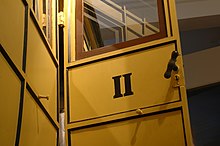LEG car no.8
| LEG car no.8 | |
|---|---|
|
In the Nuremberg Transport Museum
|
|
| Numbering: | 8th |
| Number: | 1 |
| Year of construction (s): | 1835 |
| Retirement: | 1877 |
| Axis formula : | 2 |
| Genre : | (B) |
| Gauge : | 1435 mm ( standard gauge ) |
| Length over buffers: | 5740 mm |
| Service mass: | approx. 5 t |
| Brake: | no |
| Seats: | 24 (3 compartments with 8 places each) |
The cart no. 8 of the Ludwig Railroad (LEG) is the oldest surviving railway vehicle Germany .
description
It is a 2nd class passenger car that was built in Nuremberg in 1835 for the Nuremberg- Fürth route of the Ludwigs-Eisenbahn and their first train , pulled by the eagle , according to plans by Paul Camille Denis . The vehicle is the only one that has survived from this train. The compartment caris largely made of wood and is no longer in its original state due to the modifications. It has three compartments, each accessible only through their side doors. They are equipped with two upholstered bench seats facing each other, each with four seats, glazed windows and oil lighting. The vehicle weighs about five tons and has no heating. A single journey in this car cost nine cruisers in 1835. The car was rebuilt in 1838 and 1846 and taken out of service in 1877.
conservation
The car was only preserved because of the never-proven legend that King Ludwig I of Bavaria traveled on the Ludwig Railway in this car during his visit to Nuremberg on August 17, 1836.
The king could not be present at the opening of the line on 7 December 1835 as it in December 1835 on his way to his son, King Otto , after Greece was. He did not visit the city of Nuremberg until the following year and also rode the Ludwig Railway. The return trip from Fürth to Nuremberg was carried out as a "high-speed trip" with only three cars in 5.45 minutes. However, there is no evidence that the king used carriage no. 8. On the one hand, it is unlikely that a 2nd class carriage was used to transport a king in 19th century society. On the other hand, it cannot be ruled out that the vehicle was downgraded from 1st class to 2nd class at an unknown point in time.
The rumor about the royal passenger saved the vehicle over time: Two Nuremberg citizens, the privateer Friedrich Beckh and the banker Georg Cnopf, bought the car after it was taken out of service and gave it to the Germanic National Museum . In 1925 the exhibit was loaned to the Nuremberg Transport Museum by the Germanisches Nationalmuseum . In 1952 the car was restored and the seat covers were also replaced. For the 125th anniversary of the opening of the Bavarian Ludwig Railway, the car was put on the road again in 1960 before the 1935 Adler replica. It is shown today in the permanent collection of the Nuremberg Transport Museum. For conservation reasons, the car is no longer on rails.
swell
- Labeling on the object in the Nuremberg Transport Museum
Individual evidence
- ↑ Werner Schreiner : Paul Camille von Denis - European transport pioneer and builder of the Palatinate railways . Ludwigshafen 2010. ISBN 978-3-934845-49-7 , p. 57.
- ↑ page of the DB Museum .
- ↑ Nuremberg information .
- ^ BR knowledge: history of the railway - eagle .
- ↑ page of the DB Museum .


